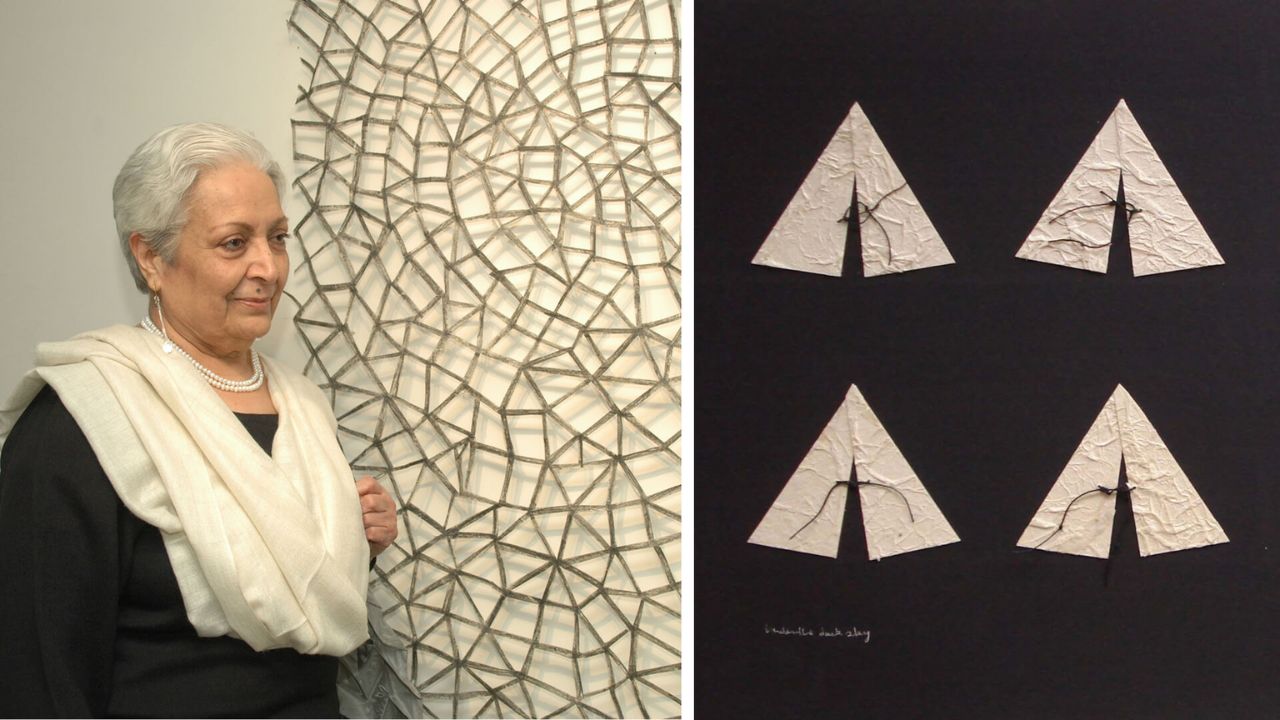Zarina Hashmi: Zarina Hashmi (16 July 1937 – 25 April 2020), professionally known as Zarina, was a New York-based Indian-American artist and printmaker. Her work encompasses drawing, lithography, and sculpture. Her work, which was associated with the Minimalist movement, employed abstract and geometric forms to elicit a spiritual response in the viewer.
Early Years
Zarina Rashid was born in Aligarh, British India on 16 July 1937 to Sheikh Abdur Rashid, a professor at Aligarh Muslim University, and Fahmida Begum, a housewife. In 1958, Zarina earned a Bachelor of Science (Honours) in mathematics from Aligarh Muslim University. She then studied various printmaking techniques in Thailand, at the Atelier 17 atelier in Paris, under Stanley William Hayter, and with the Japanese printmaker Tshi Yoshida. She was a resident and worker of New York City.
Zarina was a member of the board of the New York Feminist Art Institute and an instructor of papermaking seminars at the Women’s Centre for Learning in the 1980s. She contributed to the “Third World Women” issue of the feminist art periodical Heresies while serving on its editorial board.
On April 25, 2020, Zarina passed away in London due to complications from Alzheimer’s disease.
On her 86th birthday, 16 July 2023, a Google Doodle inspired by Zarina’s works was published.
Zarina Hashmi Career
Zarina’s art was influenced by her identity as an Indian woman of Muslim descent, as well as her lifespan of travel. She drew inspiration from Islamic religious ornamentation, particularly the regular geometry prevalent in Islamic architecture. Her early works were compared to minimalists such as Sol LeWitt because of their sparse and abstract geometric design.
The work of Zarina examined the notion of home as a fluid, abstract space that transcends physicality and location. Movement, diaspora, and exile are frequently evoked by the symbols in her artwork. For instance, her woodblock print Paper Like Skin depicts a thin black line ascending across a white background, dividing the page from the lower right corner to the upper left corner. The line has a cartographic quality that, in its winding and angular division of the page, implies a boundary between two locations or perhaps a topographical map of an unfinished journey.
Awards and scholarships
- 2007: Residency, University of Richmond, Virginia
- Residence at the Montalvo Arts Centre in Saratoga, California in 2006.
- Residence in 2002 at Williams College in Williamstown, Massachusetts
- 1994: New York Residency, Art-Omi, Omi
- Residency, Women’s Studio Workshop, Rosendale, New York, 1991
- 1990: Grant from the Adolph and Esther Gottlieb Foundation and Fellowship from the New York Foundation for the Arts
- Grand Prize, International Print Biennial, Bhopal, India, 1989
- New York, 1985: New York Foundation for the Arts Fellowship
- New York Printmaking Workshop Fellowship, 1984
- 1974: Fellowship from the Japan Foundation in Tokyo; 1969: President’s Award for Printmaking in India
Ayodeji Ibrahim Balogun Biography: Age, Birthday, Early life, Career, Facts
Zarina Hashmi Facts
- Zarina Hashmi was born in Aligarh, Uttar Pradesh, India on July 16, 1937.
- Hashmi is commonly referred to by her first name, Zarina.
- Zarina was significantly influenced by Islamic calligraphy, miniature painting, and the architectural traditions of her home country, India.
- In her work, Zarina frequently explored the themes of home, displacement, memory, and identity. She utilised floor plans, maps, and architectural elements as symbolic representations of individual and collective histories.
- She studied mathematics at Aligarh Muslim University and then art at the École des Beaux-Arts in Paris, specialising in printmaking.
- Zarina adopted a minimalist aesthetic in her artwork, which was characterised by clean lines, geometric forms, and a restricted colour pallet.
- Zarina incorporated traditional craftsmanship techniques, such as woodblock printing, embossing, and papermaking, into her artwork. She utilised delicate materials and textures to create tactile and visually captivating works.
- She was awarded the Padma Shri by the Indian government in 2011 and the United States Artists Fellowship in 2008 for her artistic contributions.
- The Museum of Modern Art in New York, the Guggenheim Museum, the Tate Modern in London, and the National Gallery of Modern Art in New Delhi have all exhibited Zarina’s artworks.


















